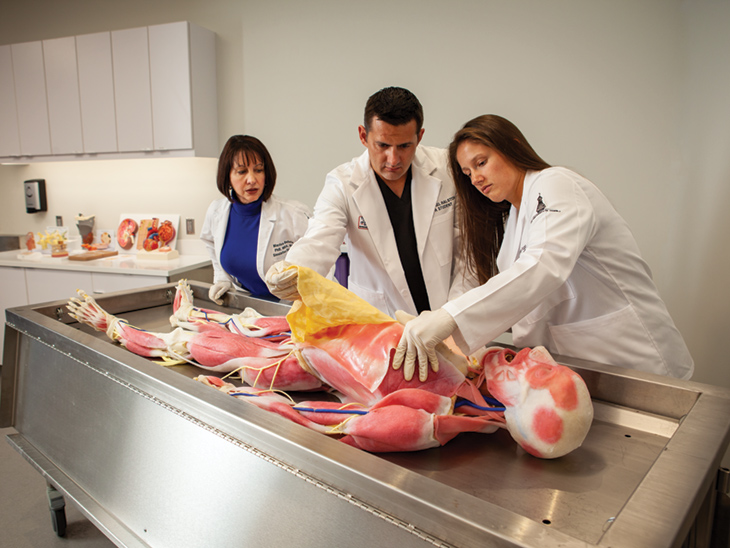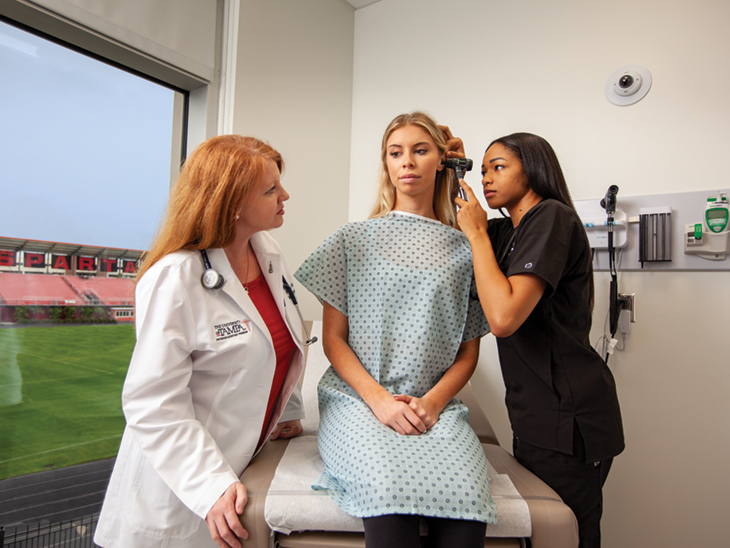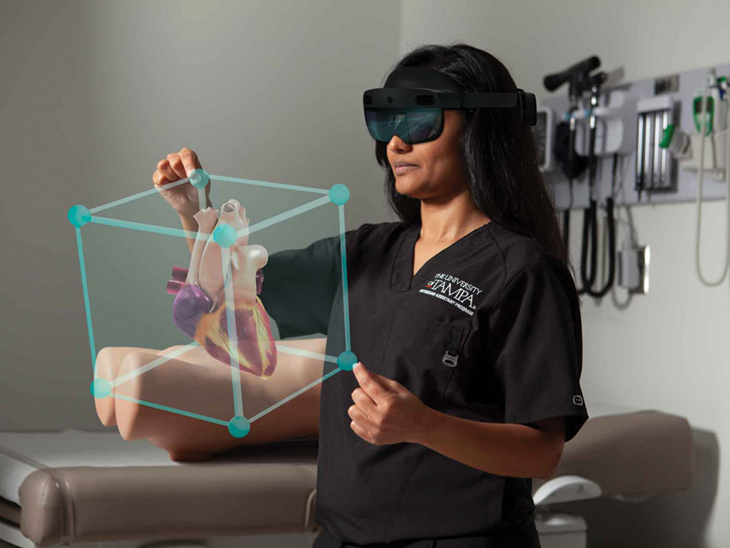Published: April 17, 2020
The PA Will See You
Take a closer look at the inaugural year of UT’s physician assistant medicine graduate program. Housed in a state-of-the-art facility, the program offers high-tech learning tools that take hands-on medicine to a new level.
 Marisa Belote, director of simulation for the program (left), advises PA students Michael Ralston (middle) and Lauren Fago (right) on how to dissect a SynDaver — a "skinless," synthetic cadaver that remains submerged in filtered water when not in use. Her name is Morticia.
Marisa Belote, director of simulation for the program (left), advises PA students Michael Ralston (middle) and Lauren Fago (right) on how to dissect a SynDaver — a "skinless," synthetic cadaver that remains submerged in filtered water when not in use. Her name is Morticia.
Before entering the exam room, Maurisha Taylor took a deep breath and told herself, “Go in with confidence.” On the other side of the door was a female teen, ready for her head-to-toe physical. Taylor walked in, smiled and followed her mental checklist.
Is the patient speaking clearly? Any skin issues like jaundice? Any hygiene problems like body odor? Any abnormalities with her eyes, ears or throat? How do her heart and lungs sound? How is her muscle strength? How does her spine look? Can any masses be felt or seen on the body? How do her veins look? How are her reflexes? Is her pulse within a normal range?
Those were only some of the 176 questions Taylor asked herself from memory as she conducted the exam. When it was over, the teen didn’t have to check out with a receptionist or pay a bill — that’s because she wasn’t a real patient. She was a UT undergraduate student who had volunteered to help Taylor, one the 48 graduate students (out of a whopping 1,700 applicants) in the inaugural class of UT’s physician assistant medicine program.
SIMULATING REAL-WORLD MEDICAL SCENARIOS
Taylor’s practice exam took place in one of the PA program’s 10 simulated outpatient clinic rooms, which look like doctors’ offices. These “sim rooms” are one of many unique features of UT’s state-of-the-art facility. During a practice exam, each PA student is evaluated in real time by a PA or medical doctor in the sim room, and each exam is videotaped so the PA student can play it back later.
Every moment of the exam is monitored carefully. “If they don’t wash their hands, they get a point off. If they don’t introduce themselves, they get a point off,” says Johnna Yealy, the founding director of the program and one of the program’s associate professors.
Later this year, actors from a local theater group will be brought in for something known as “moulage” — faking certain ailments to test the students’ ability to properly diagnose medical problems. “There’s a whole makeup mirror for the actors, just like in the theater, and they have a dressing room. We can make it look like they have a rash or a broken bone, whatever we can dream of,” says Yealy.
MAKING HISTORY
For Taylor, being part of UT’s inaugural PA class and making history is nothing new, as she’s one of multiple students in the class who is the first in her family to have a college degree. Her parents were teens when she was born. “Watching my parents grow up and not follow their dreams because they had me young, I looked at that as more of a push,” she says. Taylor was raised primarily by her grandmother, who was diagnosed with breast cancer in 2012 and survived. Watching her grandmother go through all of that solidified Taylor’s interest in going into a medical field — and possibly joining an oncology practice someday.
Choosing UT’s PA program was a no-brainer for Taylor, who worked as a medical assistant and medical scribe after college. “When I walked into the facility, I was amazed because I’d never seen a program that was so well equipped. There was no other program I could compare it to. The resources, the cadaver lab, the rotations they offered — it was so nice,” she says. “And they didn’t make the interview process feel competitive. They made it feel team-oriented.”
 PA student Maurisha Taylor performs a practice exam while Johnna Yealy, founding director of the program, looks on.
PA student Maurisha Taylor performs a practice exam while Johnna Yealy, founding director of the program, looks on.
IF YOU BUILD IT
The welcoming, collaborative vibe that Taylor noticed is one that Yealy was intent on creating when she was hired in May 2016, more than three years before the program officially launched in the fall of 2019. Her monumental task was to build a program from scratch — draft the mission statement, develop a budget, help design the facility (which takes up 30,000 square feet, the second and third floors of the Graduate and Health Studies Building), hire the faculty and staff, establish the curriculum, write the syllabi, determine the admissions policies, arrange the clinical sites, etc.
One of her largest responsibilities was earning accreditation from the Accreditation Review Commission on Education for the Physician Assistant Inc., which the program achieved in March 2019. (Without graduating from an accredited school, students wouldn’t be able to get licensed or practice medicine.)
This is the third PA program that Yealy has launched during her career, which includes being a crisis counselor in hospitals, spending 12 years as a nurse and becoming a PA, among other accomplishments. She teaches some classes along with seven other faculty members. There are also two staff members. As more students join the program over time, three more faculty members will be added, as well as one more staff member.
TOP-NOTCH FACULTY AND STAFF MEMBERS
The experience level of those faculty and staff members is a big draw for students, because the program doesn’t rely solely on PAs as instructors. A molecular biologist teaches one class, and a physiologist teaches another, for example.
“I’d say, hands down, the faculty and staff are what make this entire program successful and how phenomenal it’ll continue to be. When you see the work that they’ve done and the experiences they’ve participated in, it makes me feel safe and comfortable knowing that these powerful figures will help me develop my knowledge and learning,” says Lauren Fago ’15, a PA student from Jupiter, FL, who liked UT so much as an undergraduate that she wanted to come back for graduate school.
Her path toward becoming a PA began at the age of 15, when she sustained a major injury playing soccer. A complete ACL rupture, a medial meniscus tear and a partial MCL tear led to reconstructive surgery and early exposure to a lot of different medical professionals. “I was unhappy with my rehab care in post-op. That’s typically a time when most patients are vulnerable with anxiety. Will I be able to bend my knee again? Play sports again? I learned the importance of patient education, building a relationship, establishing trust, showing someone that you care — things you won’t learn in a textbook,” she says.
This inspired her to major in athletic training as an undergraduate at UT and take on an internship during her senior year as the head student athletic trainer for the Tampa Bay Storm arena football team. She spent 15 to 25 hours a week at practices and games doing everything from ankle taping to using ultrasound machines. After working at an orthopedic practice as an athletic trainer for a few years, she decided to get her PA degree and hopes to return to the orthopedics field in the future.
 Meet the Mannequins This is Apollo, a high-fidelity simulator (a lifelike doll that breathes, talks, blinks, moves and even vomits on command). Faculty can give him high blood pressure or a fast heart rate and then PA students like Huu Phan (left) and Teri Vrchoticky (right) must decide how to treat him. Students can see in real-time whether a treatment is helping, doing nothing or making symptoms worse.
Meet the Mannequins This is Apollo, a high-fidelity simulator (a lifelike doll that breathes, talks, blinks, moves and even vomits on command). Faculty can give him high blood pressure or a fast heart rate and then PA students like Huu Phan (left) and Teri Vrchoticky (right) must decide how to treat him. Students can see in real-time whether a treatment is helping, doing nothing or making symptoms worse.
AN INTENSIVE PROGRAM
UT’s PA program is not for the faint of heart. It’s a full-time, Monday-to-Friday program, and students are highly discouraged from working on the side. The 27-month schedule includes summer sessions and allows students little time off, but appeals to those who don’t want to slog through four years of medical school (plus a residency), accumulate more student debt and deal with possible medical malpractice lawsuits as an M.D.
During the first four semesters of classroom-based, didactic training, each student takes 68 graduate credit hours of coursework. During the clinical year, each student spends a minimum of 2,000 hours working alongside physicians and PAs in clinical practice to apply their knowledge and improve their medical decision-making skills. The clinical training takes place at local off-campus sites like Tampa General Hospital, Johns Hopkins All Children’s Hospital, BayCare and more. “There are programs in Tennessee that are sending students to Texas, to Arizona. All of our clinical rotations are in Tampa Bay, so they don’t have to move,” says Yealy.
The program attracts students who crave variety or aren’t sure yet which medical field is their favorite. “PAs practice medicine, but they’re not specialized medical providers. In other words, you’re not going to go out and be an orthopedist or a dermatologist. The training is generalist, primary care — so the nice thing is you can start working with a dermatologist and then if you want to, you can switch later on and work with an orthopedist or another specialist,” says Yealy.
PAs can collect a patient’s medical history, make a diagnosis and develop a treatment plan under the supervision of a medical doctor. If a complex or rare medical situation arises that’s beyond their scope of knowledge or if a surgical procedure may be needed, they can collaborate with their supervising physician to determine the best course of action.
A DIVERSE CLASS
One thing that stands out with this inaugural PA class is its diversity. “The normal ratio for programs is 70 to 80% female, and we’re in the 50 to 60% range. The average age for most programs is 24, and ours is 30. We’ve chosen students with life experiences and maturity, the kind of things that we can’t teach them,” says Yealy.
You’ll find a respiratory therapist, a paramedic, a lawyer, an occupational therapist, a pharmacist — you name it. PA student Huu Phan came to the U.S. as a Vietnamese immigrant at the age of 17, speaks both English and Vietnamese fluently, is a registered dental hygienist and co-owns a nail salon with his parents.
Another stat worth bragging about: 20% of the students in the inaugural class are military veterans (the average PA program rate hovers around 5%). This is something that Yealy — who serves in the U.S. Army Reserves in the Medical Support Operations Unit with the rank of major — is particularly proud of.
In fact, the history of the PA career has a military connection. In the mid-1960s there was a shortage of primary care physicians, so Eugene A. Stead, M.D., of Duke University Medical Center, put together the first class of PAs: four Navy hospital corpsmen who had received considerable medical training during their military service.
FAST FACT
Employment of PAs is projected to grow 31% from 2018 to 2028, much faster than the average for all occupations.
Source: U.S. Bureau of Labor Statistics
A COMMITMENT TO SERVICE
One person who can relate to the military connection is PA student Michael Ralston, who was in the U.S. Army infantry for four years and later became an elite Green Beret (a member of the U.S. Army’s Special Forces). During that period of his life, you might have found him leaping out of a plane at 25,000 feet in full-body armor wearing an oxygen mask to perform a top-secret raid. In his last few years in the Army, he took on an additional role as a medic, treating civilians in the developing world during emergency situations — often with the help of an interpreter.
Ralston, who has been to more countries than U.S. states and also carves out time to co-parent his 11-year-old daughter, has lived a life straight out of the movies, and he’s excited for his next chapter as a PA. “Ever since I was young, I’ve always wanted to help people,” he says. “It sounds so cliché, but I want to make an actual, tangible difference that I can see.”
Thanks to UT’s new PA program, he and the other 47 inspiring graduate students in this cohort are on track to do exactly that.
 A Taste of the Future Through a partnership with CAE — an international simulation company — PA students recently got to try out the Microsoft HoloLens 2, an augmented reality headset. Here, PA student Khushbu Patel examines a 3D image of a heart.
A Taste of the Future Through a partnership with CAE — an international simulation company — PA students recently got to try out the Microsoft HoloLens 2, an augmented reality headset. Here, PA student Khushbu Patel examines a 3D image of a heart.
 Task Trainers Task trainers are fake body parts that allow students to practice medical procedures. For instance, using a pretend arm, a student could learn how to start an IV, and using a pretend back, a student may learn how to do a lumbar puncture. Above, PA students Jessica Levasseur (left) and Agnia McGinn (right) learn how to ventilate a patient in preparation for intubation.
Task Trainers Task trainers are fake body parts that allow students to practice medical procedures. For instance, using a pretend arm, a student could learn how to start an IV, and using a pretend back, a student may learn how to do a lumbar puncture. Above, PA students Jessica Levasseur (left) and Agnia McGinn (right) learn how to ventilate a patient in preparation for intubation.
By Jane Bianchi
Photography by Alex McKnight
